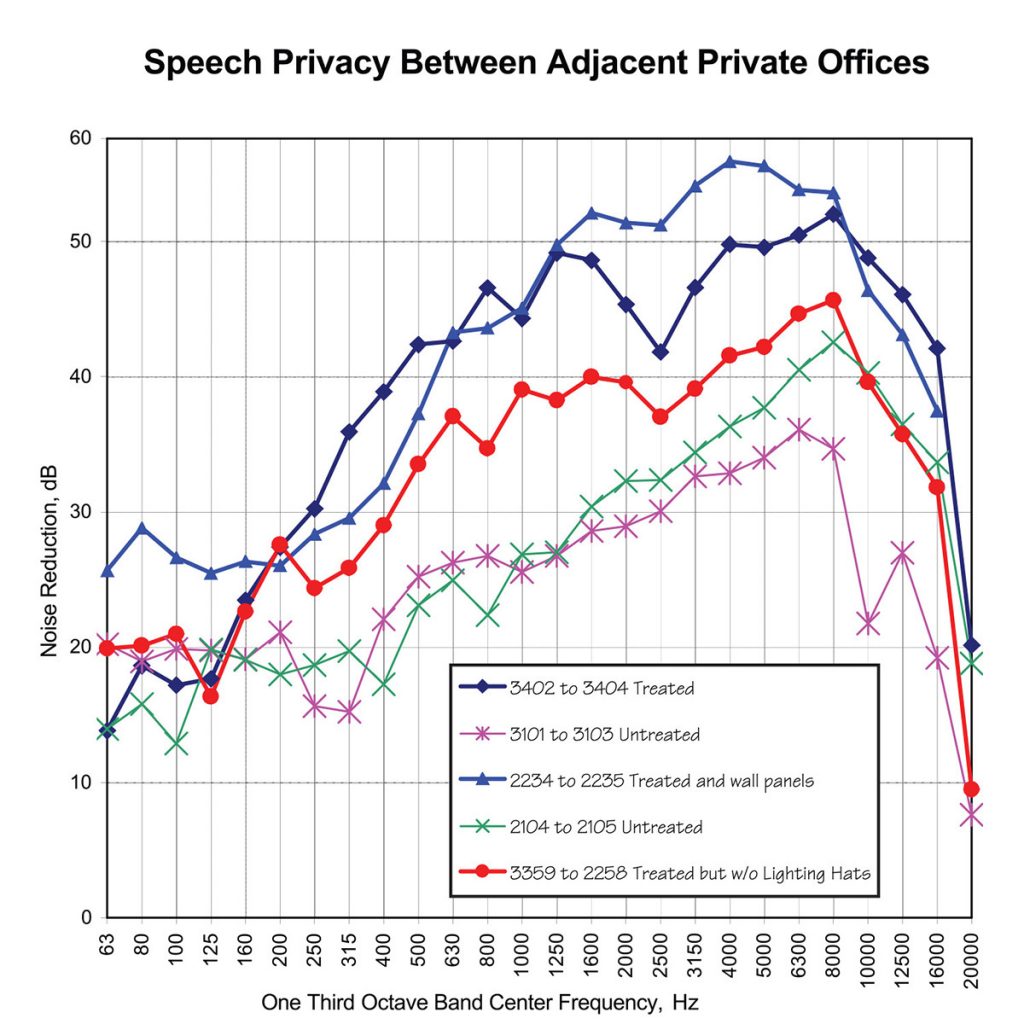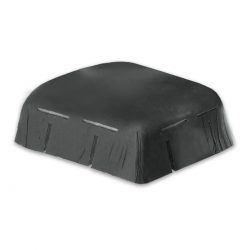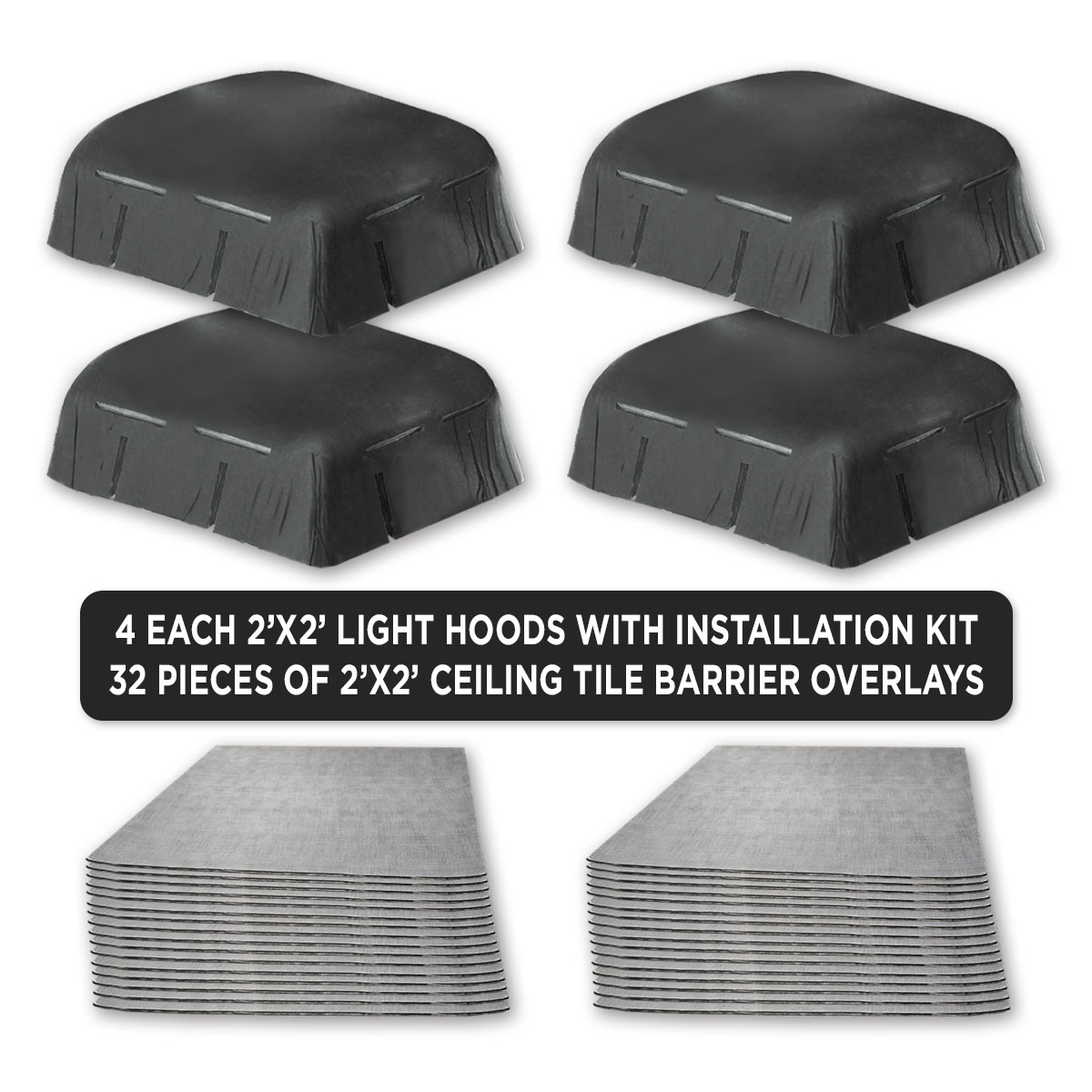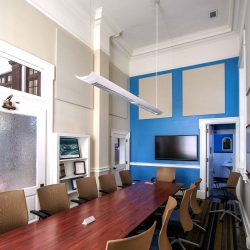Ortho Biotech
Introduction
Speech privacy is often a concern in corporate office environments, healthcare facilities, laboratory environments, and conference rooms. The typical materials used in a standard suspended ceiling grid do not provide enough sound blocking capability to prevent the transmission of sound from one office to the next. Additionally, the partition walls are not built up to the roof deck. This allows sound to flank over the wall into the adjacent room. To prevent the leakage of sound, a system of ceiling tile barriers, acoustic light hoods, barriers, and acoustical wall panels can be easily installed in each office.
The Challenge
This application will outline the process used to soundproof offices and provide some analysis of the results. Airborne sound describes sounds that travel from office to office in either direction and includes conversational speech and noise from equipment such as computers. The transmission path is not structure-borne (vibration) although, by necessity, part of the path is via the structure. Airborne Isolation is described in terms of the STC (Sound Transmission Class), or NIC (Noise Isolation Class).
The measurement of these parameters is made by producing broadband noise in one room and measuring the one-third octave spectrum in the source and receiving rooms. The difference in the measured sound levels is then adjusted for the receiving room acoustical characteristics for STC measurements (unadjusted for NIC measurements) and curve fitted to provide a one number rating of isolation performance. The basic difference between the two measures is that the STC value is a rating of the demising structure performance (wall between offices), while the NIC value describes the obtained isolation in the specific installation.
NIC
NIC is therefore the best metric to assess the speech isolation provided by the entire construction, walls, ceiling, interior materials, etc. The measurements were made using a Bruel & Kjaer Type 2250 Precision Sound Level Meter/Real Time Analyzer. A powered loudspeaker with a signal from a pink noise generator was placed in one office, and the system was adjusted to provide a sound pressure level of 95 to 100 decibels. Measurements were made at eight locations in the office in which the loudspeaker was placed (source room).
The source was left running and the measurements were repeated in the receiving office at similar locations. Measurements of background noise in the receiving space were made with the sound source off to ensure that the receiving sound levels were the result of the sound source and no other unrelated noise sources. Measurements were made in a total of 5 office pairs described in Table 1.
The Solution
PrivacyShield® Ceiling Tile Barriers were installed on top of the existing ceiling tiles to add a sound blocking material to the ceiling grid. PrivacyShield® Light Hoods were installed over top of light fixtures to prevent sound from passing through while still maintaining appropriate air flow.
The Result
The measurement results are provided in the chart below (Figure 1) and summarized in Table 1. The NIC values are calculated by curve fitting the third octave data to a standardized curve using an ASTM specified procedure. It is clear from the measurements that the treatment is effective in increasing the noise reduction (average sound pressure level in the source room – average sound pressure level in receiving room) and therefore increasing privacy between the spaces.
The NIC values for the treated rooms were 15 points higher than the untreated rooms. Further, the light hoods are an integral part of the system, with half the increase in noise reduction resulting from the addition of this component of the system. Where the fixture hoods were not yet installed (3359 and 3358), the noise reduction was noticeably lower than in the fully treated rooms. The wall treatment also increases (mainly high frequency) noise reduction and provides some increase in performance.
| Sound Transmission Loss (Hz) | |||||||||
| Location | 63 | 125 | 250 | 500 | 1000 | 2000 | 4000 | 8000 | NIC |
| 3rd Floor Untreated | 20 | 20 | 17 | 25 | 26 | 29 | 34 | 35 | 27 |
| 3rd Floor Treated: Ceiling Tiles Only | 20 | 16 | 15 | 44 | 39 | 39 | 42 | 46 | 36 |
| 3rd Floor Treated: Ceiling Tiles / Light Hoods | 14 | 18 | 30 | 43 | 44 | 45 | 50 | 52 | 42 |
| 2nd Floor Untreated | 14 | 18 | 18 | 23 | 24 | 31 | 38 | 43 | 26 |
| 2nd Floor Treated: Ceiling Tiles / Light Hoods / 1″ Acoustical Wall panels | 26 | 25 | 28 | 37 | 46 | 52 | 57 | 54 | 41 |
It is clear from the measurements that the noise isolation between private offices is clearly insufficient (less than NIC 30) under baseline conditions. With the treatment installed, the NIC values above 40 fall more in line with typical recommendations. By installing just the PrivacyShield® Ceiling Tile Barrier, the reduction for the third floor rooms was improved by approximately 33%. Combining the ceiling tile barrier with the PrivacyShield® Light Hoods contributed 22% to the total improvement of 55%. The 2nd floor experienced similar results with an increase of higher frequency reduction. This improvement is due to the addition of the 1″ thick acoustical panels installed on the interior walls.

Figure 1- 0ne third Octave Office to Office Noise Reduction values for measurements made at Ortho Biotech Facility. Data of 14 December 2004.
| Table 1 Summary of Isolation Measurements at Ortho Biotech Bridgewater NJ Facility. | ||
| Office Pair | Conditions | NIC |
| 3402 and 3404 | PrivacyShield® Ceiling Tile Barriers on top of existing tiles PrivacyShield® Light Hoods over lights | 42 |
| 3101 and 3103 | Untreated | 27 |
| 2234 and 2235 | PrivacyShield® Ceiling Tile Barriers on top of existing tiles PrivacyShield® Light Hoods over lights Interior wall treatment | 41 |
| 2104 and 2105 | Untreated | 26 |
| 3359 and 3358 | PrivacyShield® Ceiling Tile Barriers on top of existing tiles | 36 |
In the Customer’s Own Words
“The PrivacyShield® System is installed in over 200 private offices and all conference rooms in the building. The most common statement from the building occupants – ‘a night and day difference’ in regards to their Speech Privacy. I can say that the ceiling treatment not only met but exceeded our expectations.”
— PSGA Project Engineer
To learn more about how Acoustical Solutions can solve your noise control problems, use our contact form, call one of our Acoustical Sales Consultants at (800) 782-5742, or visit us on the web at acousticalsolutions.com.
















